College Football Cow Town Becomes NBA Champion City: Celebrating the Thunder in OKC
I reflect on my home team city, the Oklahoma City Thunder, winning the 2025 NBA Championship in terms of urbanism (and even some education).
“Where are you from?”
“Oklahoma.”
[Blank Stare]
“It’s above Texas.”
“Oh, ok!”
This is a conversation that I have had countless times while abroad. Oklahoma was just a one-horse cow town that most people around the world have never heard of.
Sometimes, people will know about the 1995 Alfred P. Murrah Federal Building bombing. “That was our legacy. Known around the world for the deadliest act of domestic terrorism in U.S. history,” wrote Max Gagliardi, OKC local and host of the Always Be Building Podcast. For me, I was just a little kid then, but that day is forever etched into my brain, along with the tragic and moving memorial that sits in the place of the rubble.
But on an occasion when I meet a fellow NBA fan, when I say “Oklahoma”, I don’t get a blank stare. Instead, I get “Ooh, Thunder,” “SGA!,” or far into the past, “Westbrook!”
Getting the NBA to Oklahoma City (OKC) has meant a lot to the state. For so long, we were viewed as a kind of inconsequential fly-over country. Nothing was out there. The place didn’t matter. This is at least how it felt as an Oklahoman consuming broader culture when I was growing up.
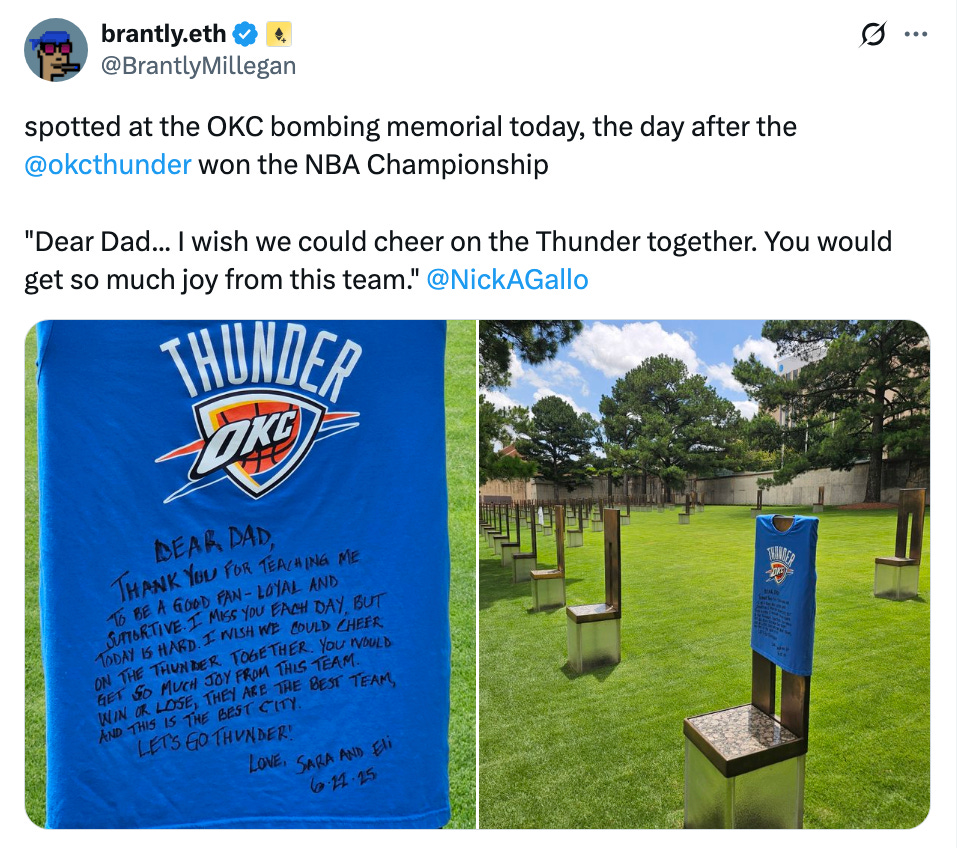
Even though I have not lived in Oklahoma for two decades now, it is still home. It has been incredible to watch from afar the growth and change happening there over the last couple of decades. Since the bombing and on through getting the Thunder, OKC has been slowly transforming beyond the terrible suburban renewal policies that left much of it desolate and surrounded by sprawl.
As a city, we see the bombing tragedy as our kind of phoenix rising from the ashes. It marked the beginning of OKC’s renaissance that led to an NBA team. During the 1990s, the city voted for the Metropolitan Area Projects Plan (MAPS), a local sales tax targeted at downtown improvement.
I wrote in a previous Financial Times article on US city redevelopment:
Oklahoma City is one of the most conservative urban metro areas in the country. But much of the incremental and steady transformations of recent years were financed through a tax increase voted on by the residents. This is a conservative state that voted on increased taxes to make their capital city denser and more walkable.
During the Great Recession, OKC was even labeled one of the places most resilient to the financial downturn, thanks to oil and natural gas and the early investment into places like Bricktown. Bricktown became a central hub for the metro area, with a downtown ballpark, riverwalk, restaurants, bars, hotels, and countless other amenities.
Still, though, there was always a chip on our shoulders as a state. While we thought Bricktown was cool, outsiders made fun of it as just a small stretch of a sprawling city and a second-rate San Antonio River Walk. Culturally, the rise would not be complete until the NBA gave Oklahoma a chance.
A College Football Town
Sports are just more important in Oklahoma than in other places I have lived (New York, Southern California, Korea, or China). They are central to the identity of many people in the state. This cultural sentiment is likely familiar to other states like Texas or Alabama, but it feels different than the US coasts.
In particular, college football has long been king in Oklahoma. People identify with either the University of Oklahoma (OU) or Oklahoma State University (OSU). Most Oklahomans never set foot in a classroom in Norman or Stillwater, but still bleed crimson and cream or orange and black. Even my fellow Bronchos at my alma mater, the University of Central Oklahoma, had primary identities as Sooners or Cowboys.
Living in Oklahoma feels like nonstop talk about these two colleges at all times. Although this is probably annoying to some of my colleagues who actually work in higher ed, since the discourse is never about academics. Well, unless the starting running back can’t make grades.
The calls into sports talk radio like WWLS the Sports Animal and its flagship show, the Total Dominance Hour with Al Eschbach and Jim Traber, are right out of central casting for the stereotype of small-town football fanatics. I sometimes whimsically tune in from California to get a nice hit of nostalgia.
Because of the intense focus on college sports, high school athletes naturally take on an outsized role in importance. It would be a fair critique of the state to say athletics is put on a pedestal while teaching and learning are secondary. This can be seen with the abysmal teacher pay and low-ranked educational outcomes.
But high school sports are highly parochial. And even college football feels more regional. The NBA is national (it’s right there in the name!), and it is really a global brand. Since the Thunder came to the city, Oklahomans have felt a pride in the state that was not there before.
With the NBA, OU and OSU fans created an alliance together that united the state. Since sports are so important to the state, getting recognition from the national and leading league was important, even if we would never admit it before we got a team. There is a kind of respect that our former cow town got through the brightest lights in sports.
Cow Town Gets NBA Team
The Thunder are not even Oklahoma’s first foray into the NBA. In 2005, Hurricane Katrina wrecked the city of New Orleans. With years of recovering ahead, the New Orleans Hornets elected to play in Oklahoma City for two seasons (from 2005-2007). The experiment worked wonders for the city’s image, with sold-out crowds and a college-like atmosphere.
I attended some of those games, and it was surreal that my city actually had an NBA team, even if they were just on loan from another wounded city. We were then, for the first time, on the same level culturally in sports as Chicago with the Bulls or LA with the Lakers. The Hornets, though, had to return to New Orleans (soon after changing their name to the Pelicans).
Even though it was sort of lucky happenstance that OKC even got a chance to host an NBA team, the city had improved so much since the bombing that it was then an attractive place for a professional team. We built up after a tragedy and were able to help out another city when they had their own.
OKC had then proved that it was a “Big League City”, the campaign slogan that then-Mayor Mick Cornett elected to use to attract another team to the city. The former Mayor Mick’s book, The Next American City, and current Mayor David Holt’s book, Big League City, both provide a much more in-depth version of this same story, worthy reads for all urbanists.

I must now concede that there are critiques of how the Seattle Supersonics became the Oklahoma City Thunder. But this is not a post about Seattle, and I truly hope they get another NBA franchise one day. I’m sure it is not easy to have lost a team.
The vitriol against OKC was strong early on when the Thunder first arrived.
NBA fans made fun of the state as a cow town that stole the team (which is a bit ironic since the Oklahoma Sooners are named after a bunch of people who cheated in the early land run days). Then popular ESPN (now The Ringer) commentator Bill Simmons even refused to call the team “Oklahoma City Thunder” early on. Instead, he decried them as the “Zombie Sonics.”

But the local fans did not listen to the national discourse that we were not worthy of a franchise. We are just happy to have a team, one that was young and exciting, even if not very good. Not being good, though, would not last for long.
MVPs in Loud City
The Seattle Supersonics actually drafted both Kevin Durant and Russell Westbrook. Durant even played one season in the Pacific Northwest before moving with the team. They were not good that first season, but that did not matter to the new OKC fans.
The crazy crowd reactions to the professional team were said to be more akin to a college football atmosphere. OKC earned the nickname Loud City. They sold out the Ford Center and started this home court advantage that has stayed with the team even to the current championship run.
Then the franchise drafted James Harden. From then on out, it was all upswing. In just two seasons of getting the full Big Three of Durant, Westbrook, and Harden, the Thunder were in the 2012 NBA finals with the three future NBA MVPs on the roster. The team, unfortunately, lost to peak Lebron James and the Miami Heat.
Everyone thought the team was destined to be back for more championships. They never were. Right before the 2012-2013 season, the Thunder traded James Harden. This is what happened in the subsequent seasons:
2012-13: Best record in the West, but Westbrook tore his meniscus, losing in the second round of the playoffs.
2013-14: Durant won the MVP and the team was 2nd in the West, but lost to an ironic Spurs team in the conference finals.
2014-15: Missed playoffs, as Durant missed much of the season with an injury.
2015-16: 3rd in West, made it to West Finals where they led Golden State 3-1 but lost in a heartbreaking 7 games.
2016-17: Durant bolted for Golden State. OKC was only 6th in the West, but Westbrook won the NBA MVP.
2017-2018: OKC traded for All-Star Paul George and future Hall-of-Famer Carmelo Anthony, but still lost in the first round.
2018-2019: 6th in the West and another first-round loss.
In 2019, Westbrook was traded, along with George. It was the end of that era, and the OKC Thunder never won an NBA title with any of the vaunted Big Three. During the worst of it, “National media questioned if OKC would still have a team,” wrote Carson Cunningham, a local sports commentator, on X.
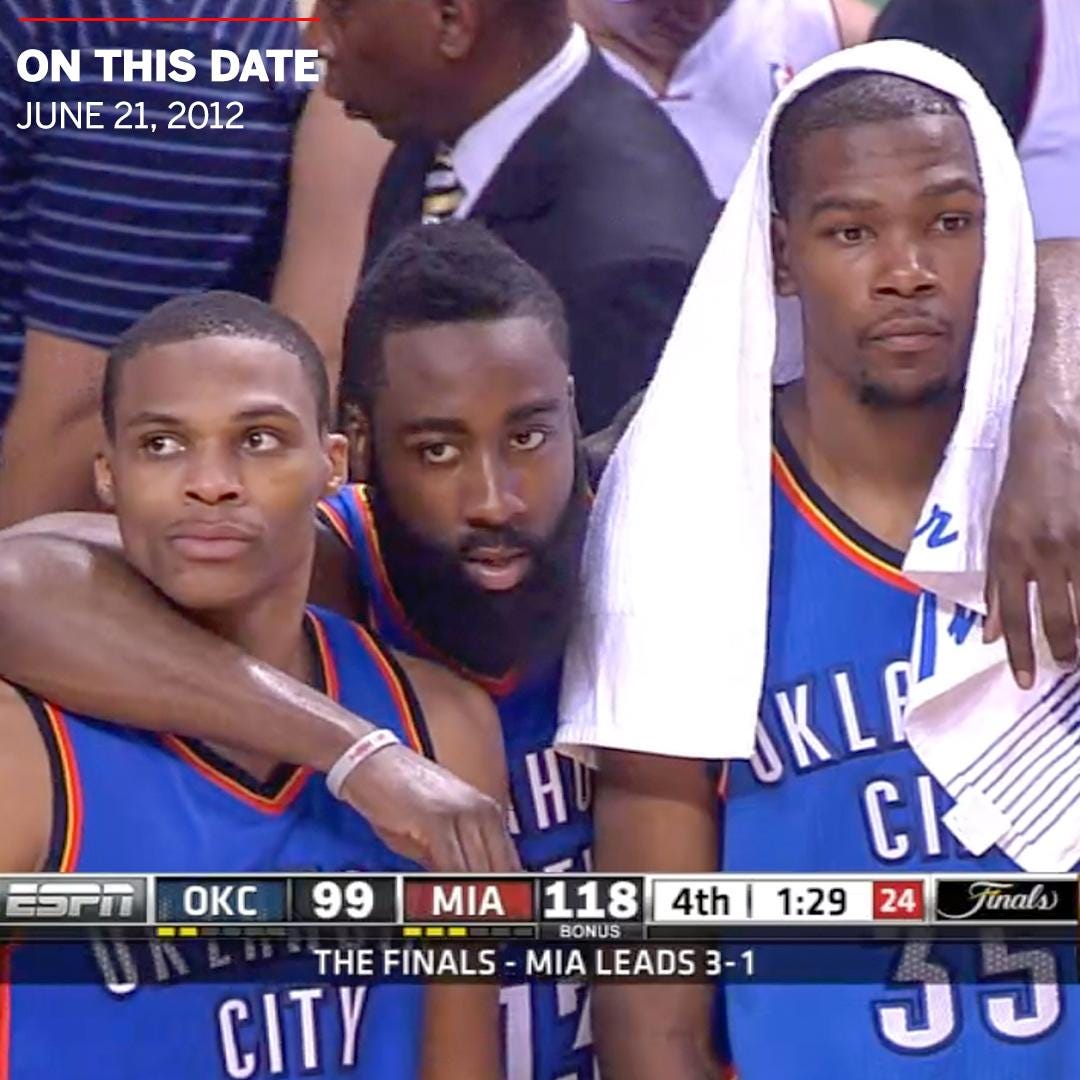
The failures were the harsh reality of pro sports and one reason some Thunder fans (including myself) felt gun-shy about the NBA. But these last trades led to the current roster of Shai Gilgeous-Alexander and the championship core. The team and fans, like the city and state, stayed resilient.
New Team In a Growing City
The OKC since 2019 has been young and hungry. The cast and crew grew into a championship contender by making moves, learning, and improving along the way. Now, that young and hungry team just won an NBA Championship, the second youngest to do so.
The growth and resilience of the team over this entire era reflect what has been happening with the city over this same period. The city has been expanding, improving, and changing for the better. Every time I go back to visit, I am stunned to see how much urbanism has been built or invested in a place that didn’t have much when I was growing up there.
After the initial success of MAPS, the city continued the investment. In 2018, the city opened the OKC Streetcar, 4.8 miles of track that connects the downtown, Bricktown, Midtown, and Automobile Alley. This was capped off with the opening of Scissortail Park in 2019, a sort of Oklahoma version of Central Park.
MAPS 3 continued funding Oklahoma River Improvements, including building or creating miles of sidewalks and trails. These connect to the Boathouse District, which is the site of a few boating-related US National Teams training grounds. This site was also selected as the 2028 Olympics whitewater venue, so now the city gets to boast at hosting (well, sort of, along with main host LA), an Olympic Games.
If the KD, Russ, Harden era was represented by the first growth spurt and the rise of Bricktown, the SGA, Jalen Williams, Chet Thunder era represented a broader growth of the city and state. These have been incremental changes in a lot of places, bringing small improvements throughout the metro.
More Work to be Done
I am not naïve: there is still work to be done in Oklahoma in terms of urbanism (and education!). I am writing this article on a high-speed train going 200 MPH from Suzhou to Shanghai. At the same time back home, Oklahoma might lose its only Amtrak service, the Heartland Flyer, due to budget cuts.
Even with all the urbanism happening, the city is still choked by highways and parking lots, and public transit broadly is not good. One glaring example I saw on my last visit was right next to the busy a dense part of downtown OKC is old suburban development McDonald’s and Burger King with massive parking lots. This is such a waste of prime space.

Basically, people have to own a car to live in OKC.
But car light is do-able, and there are pockets where some great changes are happening and still taking place. The Wheeler District is an interesting New Urbanist development. Now, there are talks of building the tallest skyscraper in the US. I think they should build Legends Tower! But perhaps they could add a little something to honor the OKC Thunder’s NBA Championship (I am only half-joking).
The broader metro is doing things, too. Edmond, where I went to college at the University of Central Oklahoma, was not a typical walkable college town. Instead, it is a sprawl suburb of Oklahoma City. People looked at me like I was crazy for trying to walk or bike back then. I even got picked up by the police once for walking home from the bar! (that is a story for another post)
Like most of Oklahoma, positive changes are coming to my former college town. One such effort comes from Austin Tunnell with his Building Culture developments. “I have a thesis: people work better in beautiful, life-giving spaces,” wrote Tunnell on X. I agree.
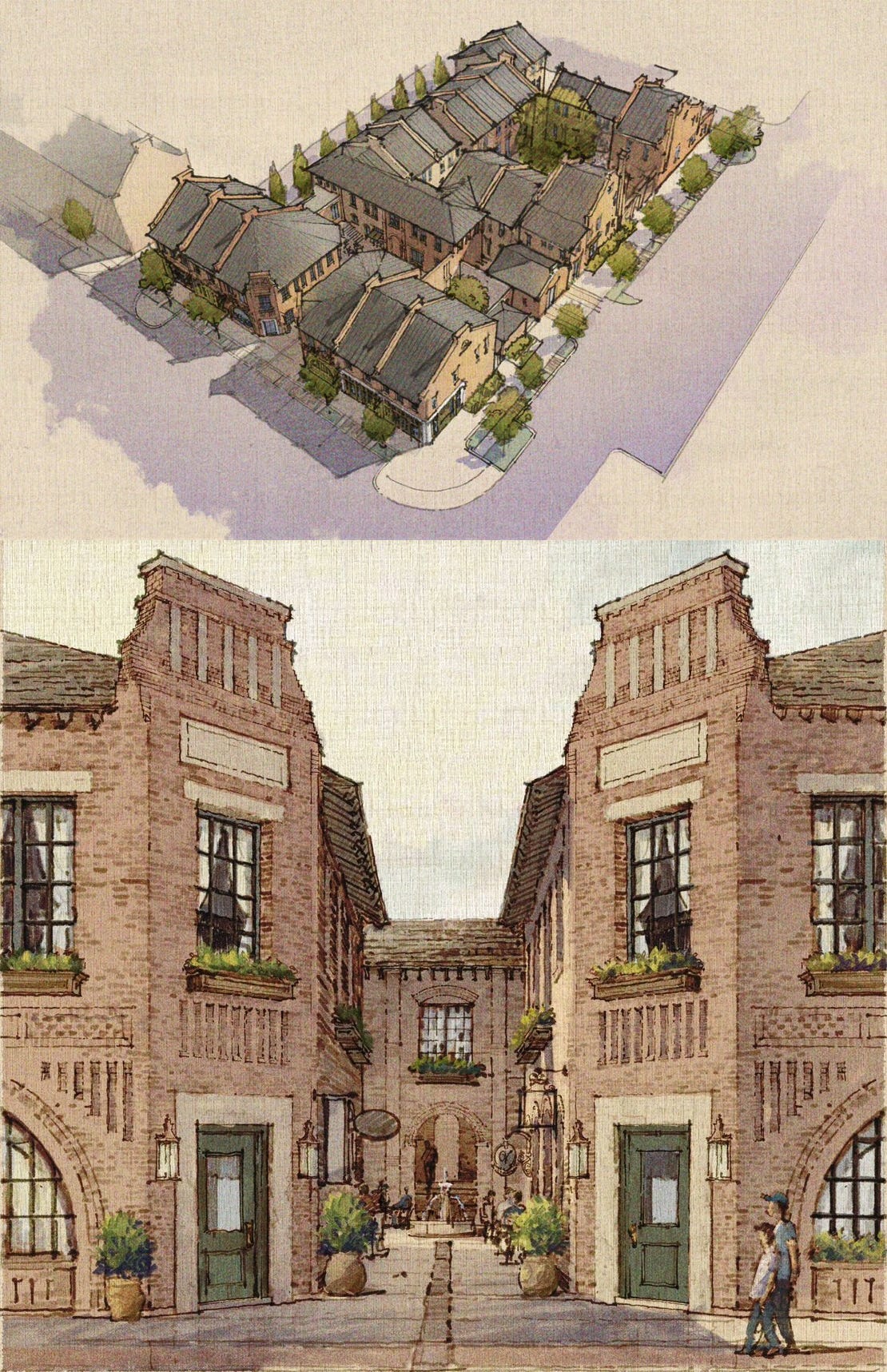
A place like Edmond, with all of its college students, is perfectly ripe for these types of improvements. Exciting developments and projects like these that start from the bottom up can be found across the OKC metro area.
Closing Out Where I’m From
The metro area (and the entire state) has rallied around the franchise. Oklahoma City as an NBA basketball team and an actual city are growing and rising fast. I can really see OKC becoming the next great American metropolis—not like New York City but something beyond the forgotten flyover country stigma.
I would describe the trajectory of OKC as a kind of mix between Portland and Houston. The sentiment around young people isn’t like on the coasts, where housing is out of reach, but rather there is an excitement in all the things that are happening in the metro in terms of urbanism.
Now, perhaps things do go off the rails and the state follows the same bad planning as California or the Northeast. There are also considerable political divides around education and other broader social issues that are still raging, too. For now, though, like the Thunder championship, there is much to celebrate in the city and state.
It is not a perfect place, but a place doesn’t have to be perfect to still be good.
Oklahoma City might still be a one-horse cow town, but that one horse is the Oklahoma City Thunder basketball team. So when I’m in Shanghai again and I tell someone I’m from Oklahoma, instead of saying “above Texas”, I get to say “where the 2025 NBA Champions play.”
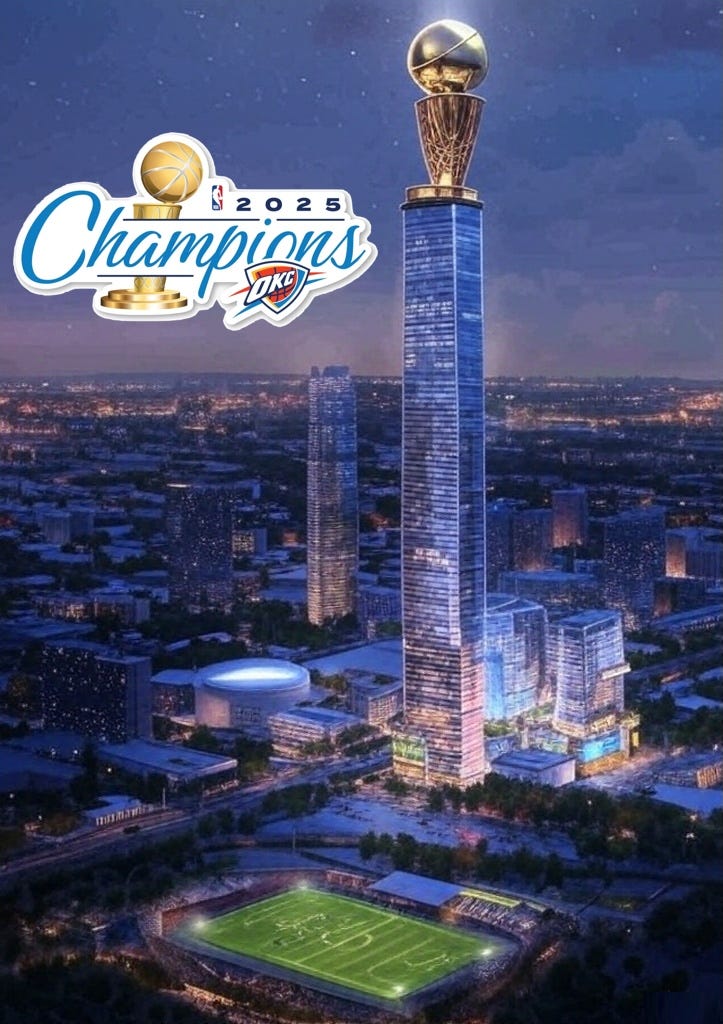
Correction (July 6, 2025): the title of Mayor David Holt’s book was added and corrected.




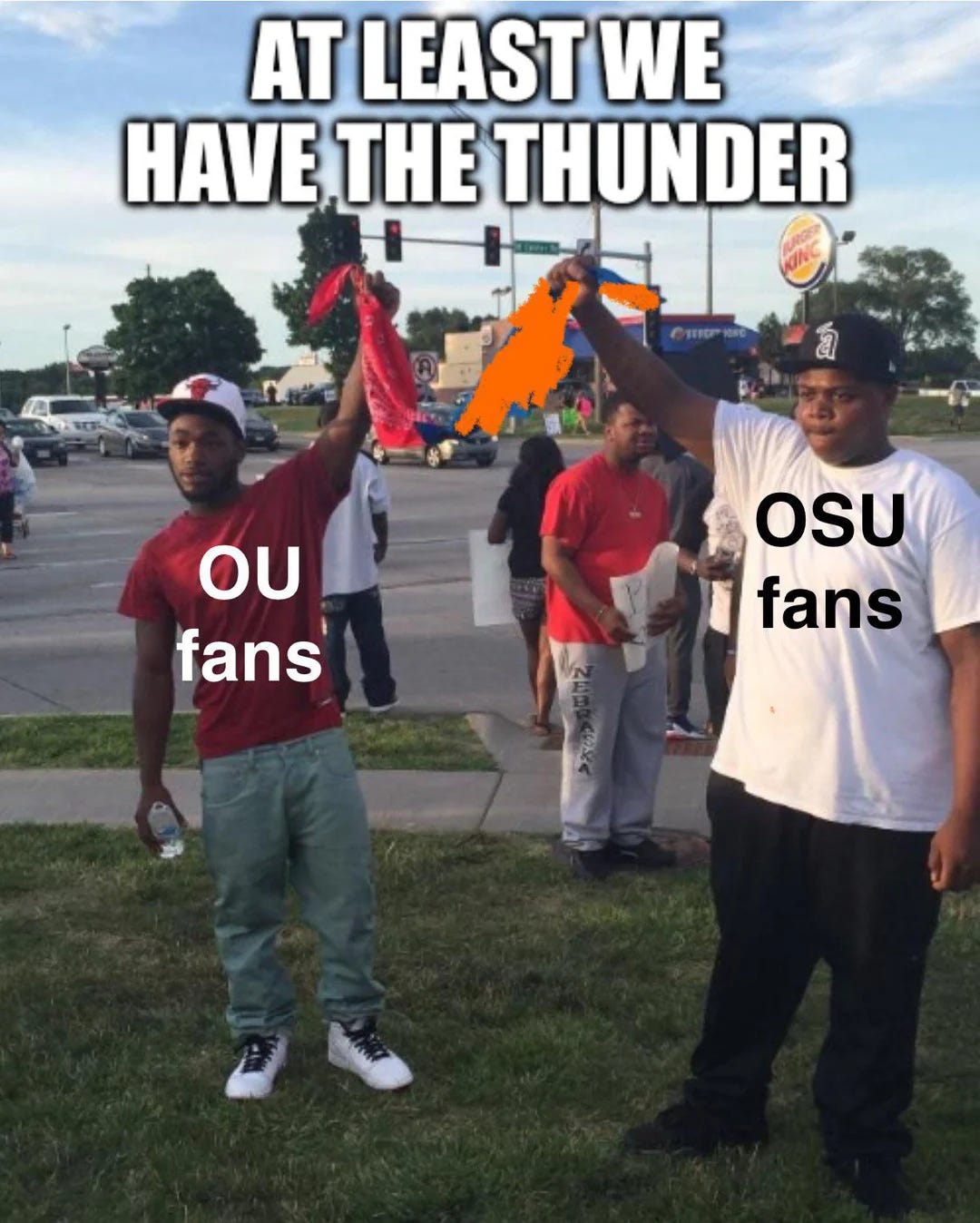

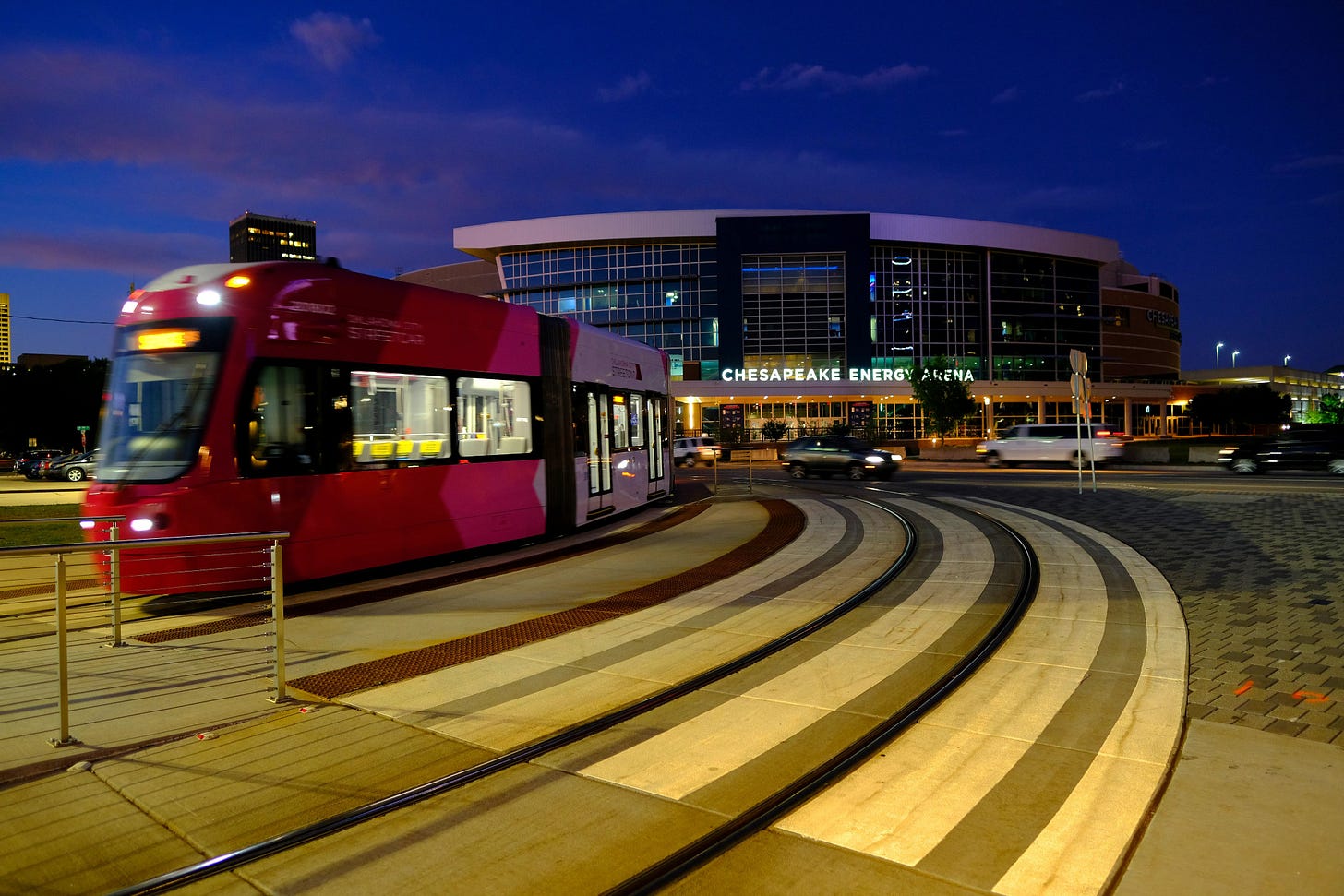
Great write up! I grew up in Edmond/NW OKC and it's been awesome watching OKC come into its own during the past 20 years. I live in Tulsa and really wish Tulsa would start doing more things like OKC. They're doing some things right, but just not at the scale as OKC. I don't sense the excitement or optimism for Tulsa like you see in OKC. That could just be me, though.
Great summary of an overlooked city! I've been fascinated by OKC ever since they got an NBA team (another way sports brings relevance), and I really enjoyed Sam Anderson's Boom Town book from 2018.